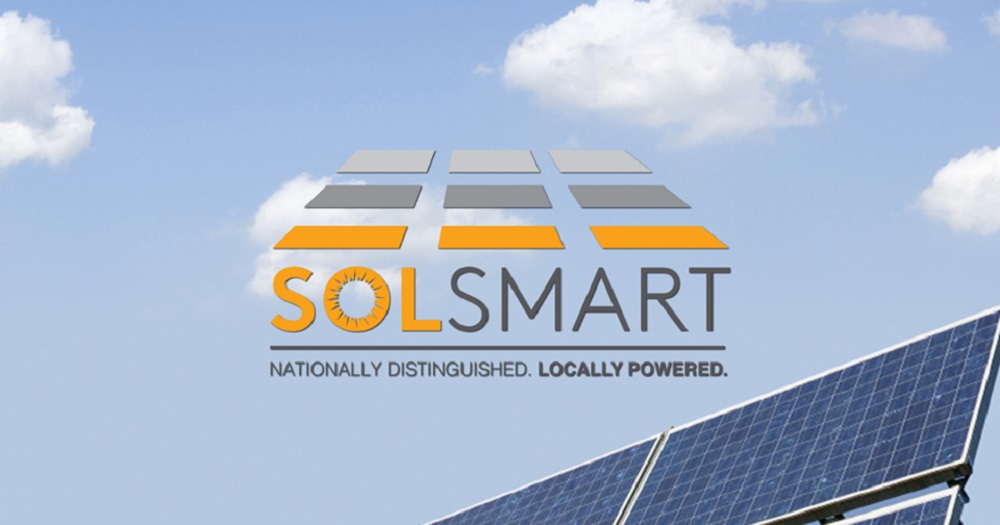https://pv-magazine-usa.com/2023/03/24/solsmart-program-sets-goal-to-designate-1000-leading-solar-communities/
SolSmart technical assistance program targets 1,000 leading solar communities by 2027

Image: SolSmart
In support of the Biden administration’s goal of 100% clean energy by 2035, the U.S. Department of Energy (DOE) set a goal to recognize 1,000 communities as solar leaders that are taking steps to reduce barriers to solar energy access.
Launched in 2016, the SolSmart program offers expert technical assistance at no cost to help local governments adopt nationally recognized best practices to advance solar energy adoption. The goal is to help municipalities save time and money by reducing the soft costs of solar adoption, which span five criteria categories: permitting and inspection, planning and zoning, government operations, community engagement, and market development. In June, the DOE announced that 60 more towns had achieved SolSmart designation.
The expanded SolSmart program adds a new platinum-level designation for the most forward-looking communities. Nearly 500 local governments in 43 states, the District of Columbia, Puerto Rico and the Virgin Island have achieved SolSmart designation at one of three current levels (gold, silver, or bronze). These local governments are in 43 states, the District of Columbia, Puerto Rico, and the U.S. Virgin Islands. The new platinum level requires a local government to earn a total of 350 points across five categories and complete certain prerequisites, including offering an instant online permitting tool for rooftop solar, such as the SolarAPP+ platform developed by the National Renewable Energy Laboratory. The government must implement partnerships and programs designed to enable the benefits of solar energy to be shared by all members of their community.
The enhanced SolSmart program also now establishes priorities around support for disadvantaged communities. A cornerstone of the program is to further the goals of the federal Justice40 initiative to provide equitable opportunities for underserved communities. The Justice40 Initiative supports programs that improve clean transit and workforce development, while also investing in programs that make clean energy more affordable and accessible and strengthen resilience to climate change. Generally these communities have a higher household energy burden, suffer the effects environmental and climate impacts, and have socio-economic vulnerabilities. Of the 500 new designees, at least 40% will be in underserved communities.
“Local governments across the country are looking to solar power to cut energy costs and transform their energy futures,” said Alejandro Moreno, acting assistant secretary for Energy Efficiency and Renewable Energy. “This is why the SolSmart program is so important. It reduces barriers to solar energy by giving communities the tools to equitably deploy solar and enjoy the many benefits including household savings, job creation, resilience, and more.”
The program has also extended its designation criteria to include solar-plus-storage, codes and standards, innovative financing, and data collection and metrics.
SolSmart’s updated and expanded designation criteria address new areas, such as:
- Integration of solar with other technologies, such as battery storage
- Equitable access to solar energy
- Updating local codes
- Data collection and metrics to measure community progress
- Innovative financing programs for solar energy
- Community planning for large-scale solar installations
SolSmart is led by the Interstate Renewable Energy Council (IREC) and the International City/County Management Association (ICMA), along with numerous other partner organizations with expertise in solar energy and local government. Funded by the DOE Solar Energy Technologies Office (SETO), this team helps local governments and regional organizations implement national best practices that reduce local barriers to solar energy development.
The program invites all cities, towns, counties, and regional organizations in the U.S. to contact the program to begin receiving no-cost technical assistance to achieve designation. For those communities that are already SolSmart-designated, the program invites them to “level up” to designation as silver, gold, or platinum.
This content is protected by copyright and may not be reused. If you want to cooperate with us and would like to reuse some of our content, please contact: editors@pv-magazine.com.




